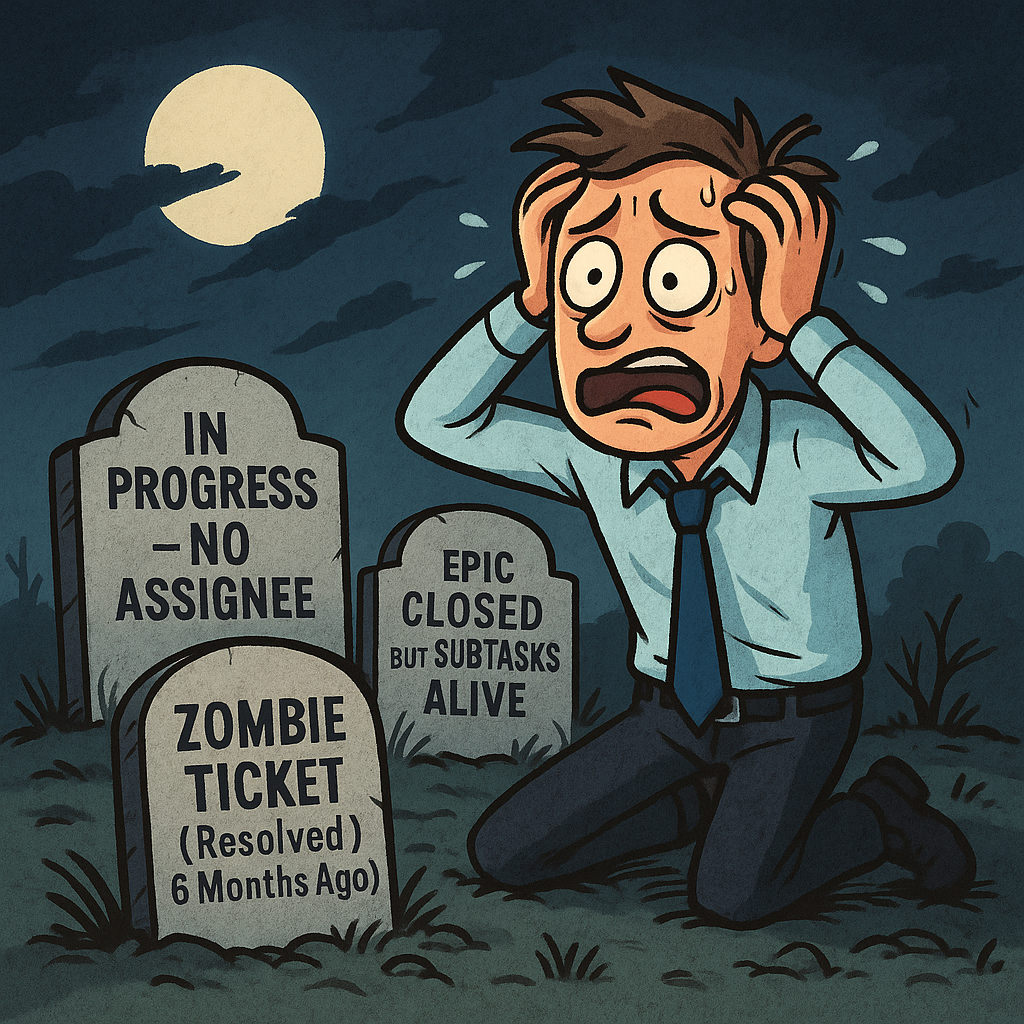A World-Weary Engineer’s Guide to Regaining Control of a Lawless JIRA Project

JIRA - A Hallowe'en nightmare ?
I’ve managed software teams, platforms, and roadmaps for years, but nothing has aged me faster than trying to maintain discipline inside a JIRA project. The codebases have been fine. Infrastructure? Manageable. Humans? Reasonably cooperative. But JIRA boards? Utter bedlam.
At some point, my backlog stopped being a planning tool and morphed into something between an archaeological dig site and a haunted house. Every time I ventured into it, I found something that really shouldn’t be there.
- Stories marked In Progress with no assignee. Spectral ownership at its finest.
- Tickets so old they could legally order a drink.
- Epics proudly marked Done while their sub-tasks continued wriggling beneath them like something you’d find under a rock.
- Mystery tickets with titles like “Look at this?” — no description, no acceptance criteria, no hope.
- Stories started without story points, because apparently estimating effort is an optional courtesy.
- Work floating around with no Epic Link, contributing to no initiative anyone could name.
It was chaos — but a quiet kind of chaos. The kind you only notice when you’re asked, “Can you generate a reliable delivery report?” and you realise the answer is no, because half the tickets are lying to your face.
How I Used to Handle It
Like every seasoned project lead, I tried diplomacy first.
- “Please assign yourself before starting work.”
- “Can you close subtasks before the parent, please?”
- “Would it kill you to add a description?”
Shockingly, this approach achieved approximately nothing.
Developers continued working however they pleased. Scrum Masters made peace with entropy. And leadership assumed everything was fine — because the board looked fine at a glance.
So, I Did the Only Sensible Thing
I stopped reminding people. And I wrote software instead.
Specifically: the JIRA Cloud Auditor plugin for my platform, Insights. It doesn’t nag. It doesn’t guilt-trip. It simply scans the entire project and politely announces:
- “This story has no description. Nobody knows what it’s about.”
- “These tasks are In Progress with no assignee. Possibly being actioned by ghosts.”
- “This epic claims to be Done, but three children are still crying beneath it.”
- “This ticket is 104 weeks old. It is now more historical document than plan of action.”
Best of all — I made the rules completely configurable.
- Don’t care about components? Turn it off.
- Want to enforce story points before starting work? Switch it on.
- Want to add custom rules like “Reject any ticket with the word ‘misc’ in the title”? Be my guest.
The Result
My JIRA project now resembles something maintained by professionals rather than gremlins.
- Epics close when they’re actually closed.
- Stories don’t sit rotting in limbo.
- Unassigned tickets are immediately named and shamed.
- And when someone forgets to write acceptance criteria, I don’t need to say a single word — the system quietly highlights their sins.
Final Thoughts
If your JIRA board is pristine and perfectly maintained, congratulations — you’re living in a different Universe from me and this post isn’t for you. But if, like me, you’ve stared at your backlog and thought: “I don’t manage a project. I manage a crime scene.”
...then perhaps it’s time to stop begging for discipline and start enforcing it pragmatically. That’s why I built Insights and the JIRA Cloud Auditor plugin. Because sometimes the only way to restore order is to codify common sense.
Take control – take a look at Insights.
Stay tuned for more updates and insights from our team. Contact us at sales@insights-online.com for inquiries.